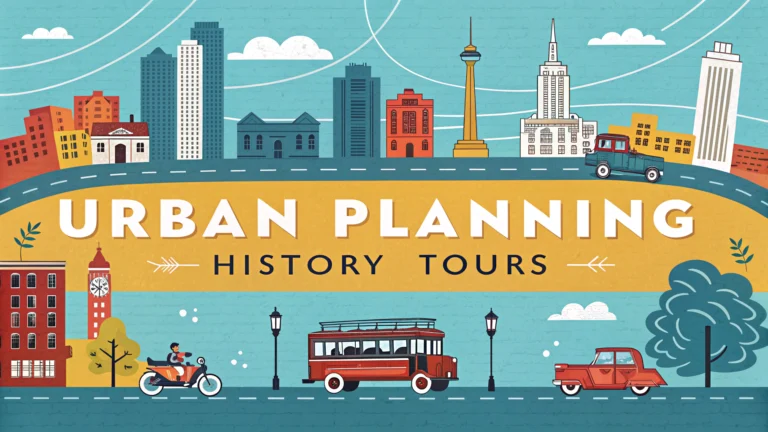Exploring a city’s urban planning history through self-guided walking tours offers insights into how communities have evolved over time.
Planning Your Urban History Walk
Before starting your walking tour, download offline maps and historical reference materials to your phone.
- Research local architectural styles and time periods
- Check weather conditions and wear comfortable walking shoes
- Bring a camera to document interesting features
- Download relevant architectural guide apps
Essential Walking Tour Elements
Focus on these key urban planning features during your walk:
- Street grid patterns and their historical context
- Building setbacks and heights
- Public spaces and parks
- Transportation infrastructure
- Architectural transitions between neighborhoods
Recommended Apps and Resources
- Google Maps – Create custom routes and save offline
- Architectural Guide Apps – PocketSights, izi.TRAVEL
- Historical Photo Apps – What Was There, History Pin
Sample Route Planning Template
| Time | Location | Features to Note |
|---|---|---|
| 30 mins | Historic District | Building styles, street width |
| 45 mins | Commercial Area | Development patterns, zoning changes |
| 30 mins | Public Spaces | Park design, civic buildings |
Documentation Tips
- Photograph building details and streetscapes
- Note changes in architectural styles
- Record street patterns and block sizes
- Compare current layouts with historical maps
Safety and Practical Tips
- Walk during daylight hours
- Share your route with someone
- Carry water and snacks
- Respect private property
- Follow local traffic rules
Contact local historical societies or urban planning departments for additional resources and guided tour options.
Check municipal websites for downloadable walking tour maps and historical information.
Recommended Reading
- “The Death and Life of Great American Cities” by Jane Jacobs
- “Cities: Reimagining the Urban” by Ash Amin
- “The Image of the City” by Kevin Lynch
Advanced Documentation Methods
Create a digital journal of your urban exploration using multimedia tools and systematic documentation approaches.
- Use geotagging for photos to map exact locations
- Create before/after comparisons with historical images
- Record audio notes about urban soundscapes
- Sketch street layouts and building profiles
Analyzing Urban Patterns
Understanding the relationship between different urban elements reveals the city’s development philosophy and historical priorities.
Key Analysis Points
- Population density influences
- Commercial vs. residential zoning evolution
- Transportation network development
- Green space distribution
Connecting with Local History
Urban walking tours provide opportunities to connect physical spaces with historical events and community development.
- Research demographic changes
- Study economic influences on development
- Identify cultural landmarks
- Track neighborhood evolution
Conclusion
Self-guided urban walking tours offer valuable insights into city planning history and community development. Through careful observation and documentation, visitors and residents alike can better understand how their city has evolved and continues to change. Regular exploration helps develop a deeper appreciation for urban design and its impact on daily life.
Future Engagement
- Join local urban planning groups
- Attend community development meetings
- Share findings with historical societies
- Contribute to digital mapping projects
FAQs
- What is the typical duration of a self-guided urban planning history tour?
Most self-guided urban planning history tours take between 1.5 to 3 hours, depending on walking pace and time spent at each stop. - What essential items should I bring on an urban planning history walking tour?
Comfortable walking shoes, a water bottle, weather-appropriate clothing, a smartphone or printed map, and a camera for documenting architectural features and urban elements. - How can I access historical information during a self-guided tour?
Through downloadable tour apps, QR codes at historical markers, printed guidebooks, or dedicated tour websites that provide detailed historical context for each location. - What are the best times of day to conduct an urban planning history tour?
Early morning or late afternoon are optimal times, avoiding peak traffic hours and extreme temperatures while offering good lighting for photography and observation. - How do I identify significant urban planning features during my tour?
Look for street patterns, building setbacks, public spaces, historical markers, architectural styles, and changes in neighborhood density that reflect different planning eras. - Are urban planning history tours accessible for people with mobility issues?
Most tours can be modified to accommodate different mobility needs by focusing on areas with proper sidewalks, ramps, and rest areas, though some historical districts may have limited accessibility. - What types of urban planning elements should I look for on these tours?
Observe zoning patterns, transportation infrastructure, public squares, green spaces, building heights, street widths, and how different historical periods influenced city development. - How can I research the historical context of an area before my tour?
Consult local historical societies, city planning departments, libraries, university archives, and online databases for historical maps, photographs, and planning documents. - What role did transportation systems play in historical urban planning?
Transportation systems shaped city growth through streetcar suburbs, railway hubs, highway development, and transit-oriented development, leaving visible patterns in street layouts and building designs. - How do I identify different historical periods of urban development?
Look for architectural styles, building materials, street patterns (grid vs. curved), lot sizes, and the relationship between residential and commercial areas characteristic of different planning eras.








